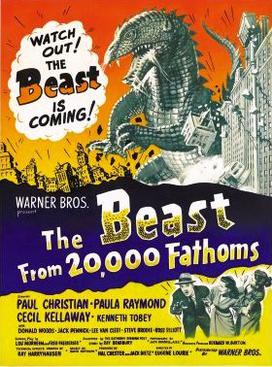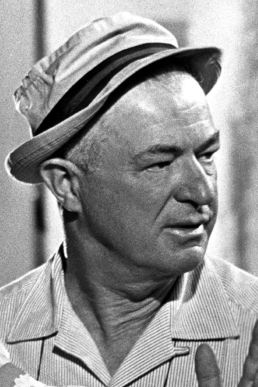
The 7th Voyage of Sinbad is a 1958 American Technicolor heroic fantasy adventure film directed by Nathan H. Juran and starring Kerwin Mathews, Torin Thatcher, Kathryn Grant, Richard Eyer, and Alec Mango. It was distributed by Columbia Pictures and produced by Charles H. Schneer.

Raymond Frederick Harryhausen was an American-British animator and special effects creator who created a form of stop motion model animation known as "Dynamation". His works include the animation for Mighty Joe Young (1949) with his mentor Willis H. O'Brien ; his first color film, The 7th Voyage of Sinbad (1958); and Jason and the Argonauts (1963), which featured a sword fight with seven skeleton warriors. His last film was Clash of the Titans (1981), after which he retired.

First Men in the Moon is a 1964 British science fiction film, produced by Charles H. Schneer, directed by Nathan Juran, and starring Edward Judd, Martha Hyer and Lionel Jeffries. The film, distributed by Columbia Pictures, is an adaptation by screenwriter Nigel Kneale of H. G. Wells' 1901 novel The First Men in the Moon.

The Beast from 20,000 Fathoms is a 1953 American science fiction action horror film directed by Eugène Lourié, with special effects by Ray Harryhausen. The film stars Paul Christian, Paula Raymond, Cecil Kellaway, and Kenneth Tobey. The screenplay is based on Ray Bradbury's 1951 short story "The Fog Horn", specifically the scene where a lighthouse is destroyed by the title character. The film is about the Rhedosaurus, a dinosaur that is released from its frozen hibernating state by an atomic bomb test in the Arctic Circle and begins to wreak a path of destruction as it travels southward, eventually arriving at its ancient spawning grounds, which includes New York City.

The Valley of Gwangi is a 1969 American fantasy Western film produced by Charles H. Schneer and Ray Harryhausen, directed by Jim O'Connolly, written by William Bast, and starring James Franciscus, Richard Carlson, and Gila Golan.

20 Million Miles to Earth is a 1957 American horror science fiction monster film directed by Nathan Juran and starring William Hopper, Joan Taylor, and Frank Puglia. It was produced by Charles H. Schneer's Morningside Productions for Columbia Pictures. The screenplay was written by Bob Williams and Christopher Knopf from an original treatment by Charlott Knight. As with several other Schneer-Columbia collaborations, the film was developed to showcase the stop-motion animation of Ray Harryhausen.

Clash of the Titans is a 1981 epic fantasy adventure film directed by Desmond Davis and written by Beverley Cross, loosely based on the Greek myth of Perseus. Starring Harry Hamlin, Judi Bowker, Burgess Meredith, Maggie Smith and Laurence Olivier, the film features the final work of stop-motion visual effects artist Ray Harryhausen.

Sam Katzman was an American film producer and director. Katzman's specialty was producing low-budget genre films, including serials, which had disproportionately high returns for the studios and his financial backers.

Sinbad and the Eye of the Tiger is a 1977 fantasy adventure film directed by Sam Wanamaker and featuring stop-motion effects by Ray Harryhausen. The film stars Patrick Wayne, Taryn Power, Jane Seymour and Patrick Troughton. The third and final Sinbad film released by Columbia Pictures, it follows The 7th Voyage of Sinbad (1958) and The Golden Voyage of Sinbad (1973).

The Golden Voyage of Sinbad is a 1973 fantasy adventure film directed by Gordon Hessler, with stop-motion effects by Ray Harryhausen. Based on the Arabian Nights tales of Sinbad the Sailor, it is the second of three Sinbad films released by Columbia Pictures, the others being The 7th Voyage of Sinbad (1958) and Sinbad and the Eye of the Tiger (1977). The film stars John Phillip Law, Tom Baker, Takis Emmanuel, and Caroline Munro. It was a worldwide box office hit and won the first Saturn Award for Best Fantasy Film.
The 3 Worlds of Gulliver is a 1960 American Eastmancolor fantasy adventure film loosely based upon the 1726 novel Gulliver's Travels by Jonathan Swift. The film stars Kerwin Mathews as the title character, June Thorburn as his fiancée Elizabeth, and child actress Sherry Alberoni as Glumdalclitch.

Mysterious Island is a 1961 science fiction adventure film about prisoners in the American Civil War who escape in a balloon and then find themselves stranded on a remote island populated by giant and tiny animals.

Naftuli Hertz "Nathan" Juran was an Austrian-born film art director, and later film and television director. As an art director, he won the Oscar for Best Art Direction in 1942 for How Green Was My Valley, along with Richard Day and Thomas Little. His work on The Razor's Edge in 1946 also received an Academy nomination. In the 1950s, he began to direct, and was known for science fiction and fantasy films such as Attack of the 50 Foot Woman. He was also the brother of quality guru Joseph M. Juran.

The Rhedosaurus is a fictional dinosaur that debuted in the 1953 monster film The Beast from 20,000 Fathoms, directed and co-written by Eugène Lourié. The Rhedosaurus is depicted as a giant, destructive, prehistoric reptile that is immune to most modern artillery in its major on-screen appearance, and would later appear in the 1977 science fiction film Planet of Dinosaurs.

Kerwin Mathews was an American actor best known for playing the titular heroes in The 7th Voyage of Sinbad (1958), The Three Worlds of Gulliver (1960), and Jack the Giant Killer (1962).

The Giant Claw is a 1957 American monster film from Columbia Pictures, produced by Sam Katzman, directed by Fred F. Sears, that stars Jeff Morrow and Mara Corday. Both Sears and Katzman were well known as low-budget B film genre filmmakers. The film was released as a double feature with The Night the World Exploded.

Charles Hirsch Schneer was an American film producer, best known for working with Ray Harryhausen, the specialist known for his work in stop motion model animation.

Mega Shark Versus Giant Octopus is a 2009 American-British monster disaster film distributed by The Asylum, released on May 19, 2009, in the United States and on August 7, 2009, in the United Kingdom. It was directed by Ace Hannah and stars singer Deborah Gibson and actor Lorenzo Lamas. The film is about the hunt for two prehistoric sea-monsters causing mayhem and carnage at sea, and is the first installment in the Mega Shark series of films.

Creature with the Atom Brain is a 1955 American zombie horror science fiction film directed by Edward L. Cahn and starring Richard Denning.

Cephalopods, usually specifically octopuses, squids, nautiluses and cuttlefishes, are most commonly represented in popular culture in the Western world as creatures that spray ink and use their tentacles to persistently grasp at and hold onto objects or living creatures.




















